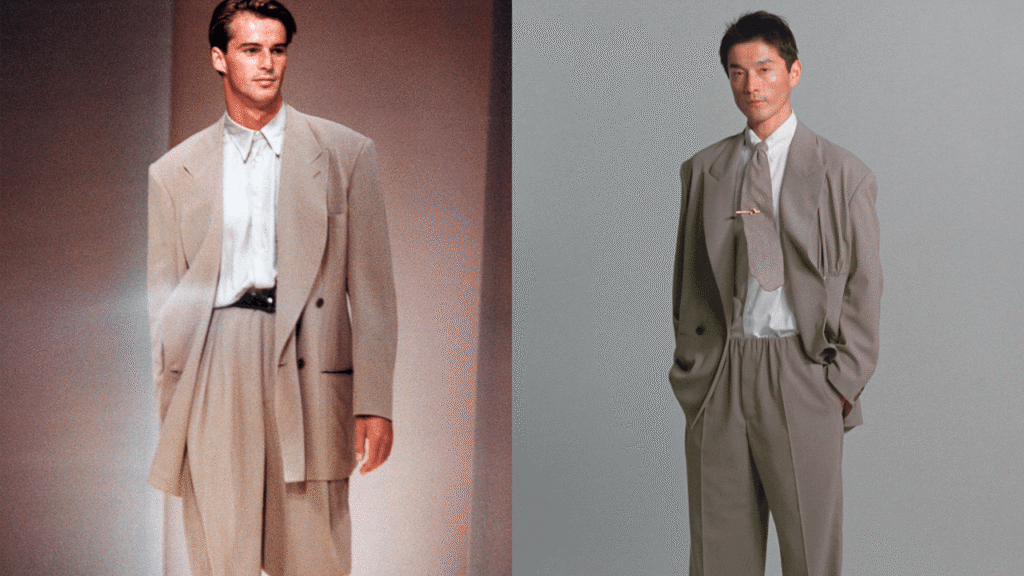The late Giorgio Armani is best known for remaking menswear in the 1980s and 1990s. But his influence on contemporary menswear is perhaps more palpable than ever.
He’s there in the parade of louche double-breasted blazers draped over voluminous pleated pants shown at Saint Laurent’s fall 2025 menswear show. He’s there in the swaggering drama of Fear of God’s cocoon-like silhouettes. The Row’s lush minimalism, Lemaire’s elevated everyday uniform, Stoffa’s monochromatic modular wardrobe, even Demna’s hulking tailoring at Balenciaga—all of it grew from the seeds that Mr. Armani planted. Just yesterday, the Japanese designer Soshi Otsuki was awarded the prestigious LVMH Prize for his namesake collection of softly tailored, elegantly insouciant suits, which owe a great debt to the pioneering vision of Mr. Armani some 40 years ago.
And lately—as if designers suddenly understood it was time to give Mr. Armani his flowers while they could—there have been even more overt recognitions of his influence. The influential menswear brands Kith and Our Legacy both released collections in collaboration with Armani, a new generation kissing the ring of a master; meanwhile, the secondary market for his clothing is on fire. In 2025, everybody wants to dress like 1990s Armani.
We know now that, when he arrived on the scene in 1975, it is no understatement to say that Giorgio Armani ushered in a revolution. A former medical student, he reworked the suit to highlight the body, not hide it. His designs contrasted menswear in the 1950s and ’60s, when suits were rigid, built to contain and streamline a man’s physicality. Armani went the opposite direction by ripping out the lining and reworking the construction to allow his garments to hang gracefully, reshaping the male figure as something more expansive and even romantic. The result was a triumph of sensuality. He used fabrics that begged to be touched. His suits were soft, fluid, almost erotic. He made men into objects of desire and suits into something they had never been before: sexy. The fashion world was never the same.
Beyond that, he showed men how to wear suits in new ways: with a cashmere T-shirt or a weightless knit sweater; in fine-tuned shades of the same calming palette—gray, beige, khaki, navy. They could be worn with sneakers or sandals, even during off-duty hours, or a night out, or the weekend. These were suits that weren’t about conformity, but individuality.
Mr. Armani was uncompromising in his vision and rarely, if ever, wavered from it. Trends came and went, but he stood firm. He knew his idea of masculinity—and consumers did too. He stood for something, he believed in it. It wasn’t a passing fancy, it was his, it was real. Let other designers follow the fickle tides of fashion; you always knew, in an instant, what the Armani man looked like.
Every designer suitmaker that followed would inevitably be compared to Armani: Thom Browne’s shrunken tailoring, Hedi Slimane’s skinny silhouettes, and Band of Outsiders’s twee prep were all the more fascinating because they stood in contrast to the original. In the 2010s, the world began to sour on suits in the thrall of casual streetwear, before the pandemic hastened their alleged demise. And yet, here we are, with a new generation of designers and consumers back in their thrall. And, what style do they all credit as their inspiration? Armani, of course.
In the coming days, there will be plenty of deserved odes and remembrances to Mr. Armani and his enduring influence. He was, indeed, a visionary, prescient in many ways. Before athleisure became a hashtag, he embraced performance-wear with his Emporio line. Before high-low collaborations were de rigueur, he embraced democratic design with his Armani Exchange line. He bucked the trend of corporate acquisitions, choosing instead to remain independent and build a multibillion-dollar business off his name. Say Armani and you instantly have a vision in your head—chic, sleek, undeniably sexy.
And yet, you don’t need a remembrance. You need merely to look around you. On red carpets, on social media, on the racks of the coolest stores in town, on the streets of any cosmopolitan city, his influence remains. Perhaps now more than ever.


